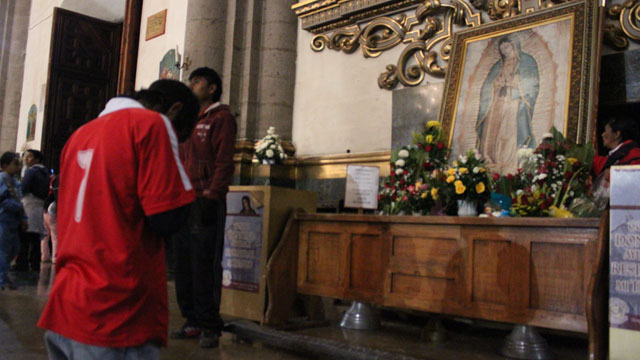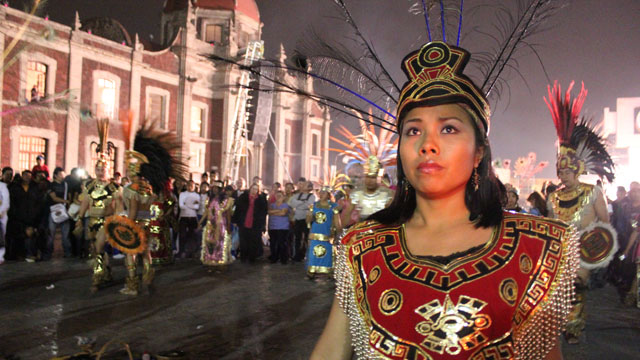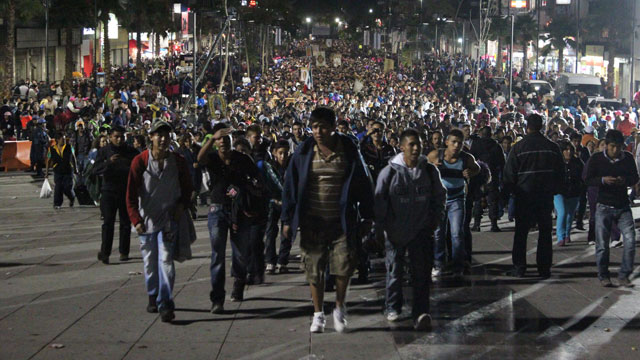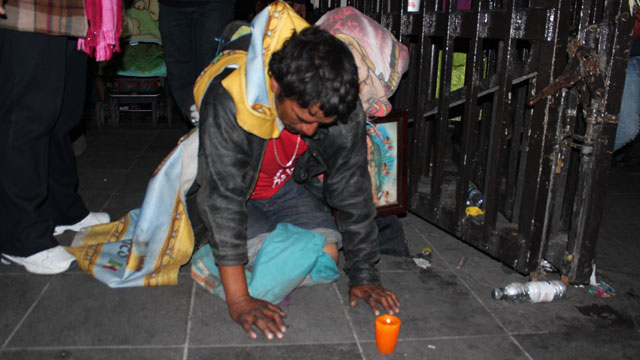Undeterred by Distance Mexican Pilgrims Flock to Virgin of Guadalupe Site
Mexican Pilgrims Flock to Virgin of Guadalupe Site
Dec 12, 2012— -- The families camped outside the basilica for hours, sleeping on thin mattresses laid on the ground. Some of them had walked up to two days from remote villages. Still, there was a festive mood around Mexico City's Tepeyac Hill on Tuesday night, as thousands gathered at this holy site, to launch Mexico's annual Virgin of Guadalupe Festivities.
The religious event, which occurs every December 12, begins at midnight with a concert in which Mariachis and other musical groups sing the birthday song, "Las Mañanitas," to the revered Virgin. In the hours leading up to midnight, hundreds of thousands of people file past the basilica to pray to the virgin, ask her for favors, or simply to give thanks for the blessings they have received this year.
We visited the Tepeyac religious complex on Tuesday night, as people prepared to launch this year's Guadalupe celebrations, and found several heartwarming stories. Here are some of them.
Magdaleno Sanchez

Magdaleno Sanchez, a carpenter, came to the basilica with 16 members of his family, including his nephew and his son. We found him resting under a tent made from plastic sheets. While he spoke, small kids played on colorful but thin blankets that the Sanchez family had laid out on the concrete floor.
"We came from the Valley of Chalco, from Huilcatlan de Flores" Sanchez said, explaining that his family walked for more than a day to reach Mexico City. Sanchez said he was used to walking long distances, as he makes the same pilgrimage to the basilica every year.
"Everything feels better when you're here," said Sanchez, who is originally from Oaxaca. "We come here to give thanks to God, that things are going well."
Armando Rodriguez

Armando Rodriguez approached the Virgin of Guadalupe basilica on his knees, carrying a statue of the Virgin that was about a foot and a half tall. Sweat broke out from this pilgrim's forehead as he held the statue, which must've weighed at least 40 pounds. But Rodriguez was modest about his effort. "It's not that heavy," Rodriguez said as I kneeled down to ask him a few questions.
Rodriguez, it turns out, came all the way from Queens, New York, where he works as a cook. It was his first time in Mexico in ten years, and he wanted to thank the virgin for this opportunity to return home.
"I came to spend these holidays with my family and to celebrate the virgin's day," Rodriguez said. "I've been living out of the country for the past 17 years, and there is a lot to be thankful for."
The Virgin's Story

In case you're wondering where all this devotion originated, it started back in 1531, when the Virgin Mary is said to have appeared to an indigenous peasant called Juan Diego.
According to texts written in the 16th and 17th centuries, Mary appeared to Juan Diego on December 9, 1531. Speaking to Juan Diego in Nahuatl, the language of the Aztecs, Mary asked for a church to be built on Tepeyac Hill. Juan Diego reported this incident to the Spanish Archbishop in Mexico City, who suggested that he ask this woman for proof of her identity.
In a second apparition, the Virgin Mary told Juan Diego to collect roses from the Tepeyac hill and take them to the archbishop, but this was happening at a time of year that roses did not grow in Mexico City, and Tepeyac was an arid hill where flowers were unlikely to grow, in any case. Still, Juan Diego obeyed and miraculously found red roses on the hill. When he gave the rose petals to the archbishop, removing them from his cloak, the image of the Virgin Mary that is now depicted in paintings, is said to have appeared on Juan Diego's cloak. This reportedly happened on December 12th, 1531.
Unclear Origins

There is debate among scholars however, as to how the Virgin of Guadalupe got that name. Some argue that the name was borrowed from a virgin of the same name in the Spanish province of Extremadura, who is credited for performing miracles. Others, argue that it is possibly an adaptation of several Aztec names including Coatlaxopeuh which means "the one who crushes the serpent." In this case, the serpent would be the Mesoamerican God Quetzalcoatl.
Millions of Faithful

The millions of faithful who attend the Guadalupe festivities are largely unaware of such historical debates. Mexico's City government estimates that six million people will attend this year's Virgin of Guadalupe celebrations, which begin on December 11 and end on Dec 12.
Dramatic Pilgrimage

For some pilgrims, the journey to the basilica is in itself dramatic. This man, named Jorge Mencini, travelled to Mexico City on foot from the state of Puebla. He said that while his family walked through a rural area near the town of Amecameca, a group of horses charged his group, and injured his brother, breaking his foot. Mencini, who entered the basilica complex on his knees, is now praying for his brother's recuperation.